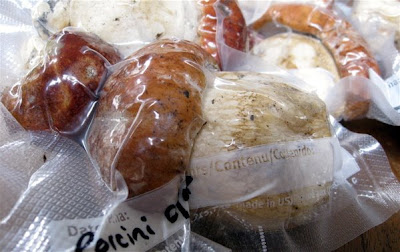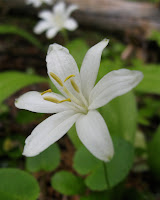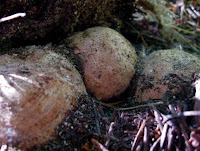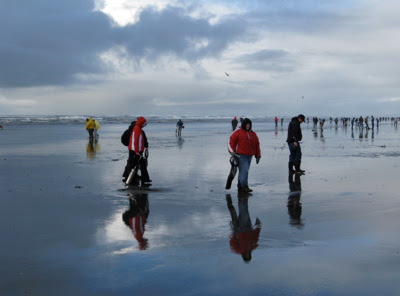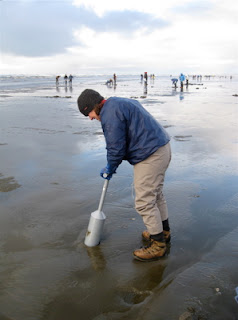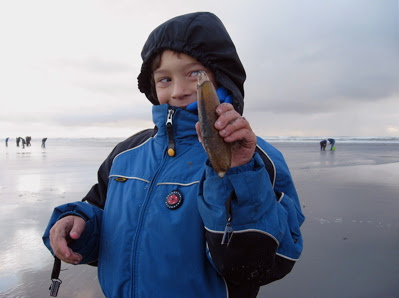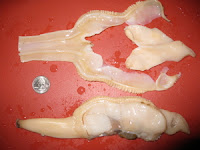 Screw on your berry snout because the time is now to sniff out one of the great treats of late summer. By general consensus among the berry cognoscenti, the western huckleberry enjoys a position at the pinnacle of berry crops across the brakes of North America.
Screw on your berry snout because the time is now to sniff out one of the great treats of late summer. By general consensus among the berry cognoscenti, the western huckleberry enjoys a position at the pinnacle of berry crops across the brakes of North America. East Coast blueberries, long since domesticated and hybridized into amusement park proportions for lowest common denominator taste buds, may be the sweetest of the Vacciniums, but the wild huckleberry, with its complex sparring of sucrose and tang, is the berry of record for true aficionados. And while FOTL can’t consider himself an aficionado yet (he’s only been picking huckleberries off and on for a mere two decades), he knows ’em when he sees ’em.
East Coast blueberries, long since domesticated and hybridized into amusement park proportions for lowest common denominator taste buds, may be the sweetest of the Vacciniums, but the wild huckleberry, with its complex sparring of sucrose and tang, is the berry of record for true aficionados. And while FOTL can’t consider himself an aficionado yet (he’s only been picking huckleberries off and on for a mere two decades), he knows ’em when he sees ’em.
 Last weekend we captained the Loaf down to one of the most storied berry patches in the land, the Indian Heaven Wilderness in the center of the volcanic triangle of Hood, Adams, and St. Helens. Indian Heaven is a seismic plateau of lavaflows and ancient, long-foundering cinder cones, a snowtrap in winter and a meltwater sponge through the summer—conditions that make it a Mosquito Heaven for sure, and a Huckleberry Heaven of tall-tale grandeur as well. For hundreds, probably thousands of years the Yakama and Klickitat tribes gathered here in summer to hunt, fish, pick berries, play games, and race horses. The Indian Racecourse is still around, as are the great berry fields, an accident of fire ecology that was later accentuated by purposeful fires set by the Indians themselves to choke out competing groundcover and keep the canopy open.
Last weekend we captained the Loaf down to one of the most storied berry patches in the land, the Indian Heaven Wilderness in the center of the volcanic triangle of Hood, Adams, and St. Helens. Indian Heaven is a seismic plateau of lavaflows and ancient, long-foundering cinder cones, a snowtrap in winter and a meltwater sponge through the summer—conditions that make it a Mosquito Heaven for sure, and a Huckleberry Heaven of tall-tale grandeur as well. For hundreds, probably thousands of years the Yakama and Klickitat tribes gathered here in summer to hunt, fish, pick berries, play games, and race horses. The Indian Racecourse is still around, as are the great berry fields, an accident of fire ecology that was later accentuated by purposeful fires set by the Indians themselves to choke out competing groundcover and keep the canopy open.
 Among famous berry-picking locales (a few that come to mind include Glacier NP in Montana and the Blue Mountains in northeast Oregon), Indian Heaven has to be the most prolific I’ve ever seen, with some of the biggest and tastiest berries to be found anywhere. This year the berries are 2-3 weeks late in much of the Northwest due to lingering snowpack and a hard spring, so the season was just getting going.
Among famous berry-picking locales (a few that come to mind include Glacier NP in Montana and the Blue Mountains in northeast Oregon), Indian Heaven has to be the most prolific I’ve ever seen, with some of the biggest and tastiest berries to be found anywhere. This year the berries are 2-3 weeks late in much of the Northwest due to lingering snowpack and a hard spring, so the season was just getting going.  We came from the north, a long slog on forest roads 25, 90, 30, and 24, arriving finally at Sawtooth Mountain flanking the northern end of Indian Heaven and the beginning of Huckleberry Nirvana. Indians picked along the roadside, using improvised milk jugs with lanyards to free up both hands. A sign on the east side of the road laid out the terms of engagement (see image above). Just past the PCT we came upon this view of Mt. Adams to the northeast.
We came from the north, a long slog on forest roads 25, 90, 30, and 24, arriving finally at Sawtooth Mountain flanking the northern end of Indian Heaven and the beginning of Huckleberry Nirvana. Indians picked along the roadside, using improvised milk jugs with lanyards to free up both hands. A sign on the east side of the road laid out the terms of engagement (see image above). Just past the PCT we came upon this view of Mt. Adams to the northeast.
 Washington and Oregon host a dozen species of huckleberries. Two of the most prominent (and the two we’re pretty sure we picked) are the thin-leaved huckleberry (Vaccinium membranaceum) and the oval-leaved huckleberry (Vaccinium ovalfolium). V. membranaceum has very large, sweet purple berries; these are the berries sought after by most pickers because of their size and taste.
Washington and Oregon host a dozen species of huckleberries. Two of the most prominent (and the two we’re pretty sure we picked) are the thin-leaved huckleberry (Vaccinium membranaceum) and the oval-leaved huckleberry (Vaccinium ovalfolium). V. membranaceum has very large, sweet purple berries; these are the berries sought after by most pickers because of their size and taste.  The other, V. ovalfolium, looks more like a small bleuberry with a slightly glaucous waxy sheen; they’re smaller in size, though a good bush can be covered with scores of them, and the flavor is tarter, making V. ovalfolium a preferred huckleberry for jams and jellies. You can see the differences in size and color between the two species in the video and image below.
The other, V. ovalfolium, looks more like a small bleuberry with a slightly glaucous waxy sheen; they’re smaller in size, though a good bush can be covered with scores of them, and the flavor is tarter, making V. ovalfolium a preferred huckleberry for jams and jellies. You can see the differences in size and color between the two species in the video and image below.
 If you go a-huckleberrying, do yourself a favor and fashion a proper bucket that can hang around your neck. A word of warning though: I know of a guy, an experienced ex-forest service employee, who was picking Oregon grape berries with a similar leashed bucket. He was picking so fast he inadvertently scooped an entire bees’ nest into the bucket. As the mad bees started swarming over the berries he saw his error and tried to run away but the bucket naturally followed him. Throwing it did no good. Lots of screaming and running in circles ensued. Finally he had to concede to the reality of the leash and lift the lanyard over his head, effectively putting his face right in the bucket.
If you go a-huckleberrying, do yourself a favor and fashion a proper bucket that can hang around your neck. A word of warning though: I know of a guy, an experienced ex-forest service employee, who was picking Oregon grape berries with a similar leashed bucket. He was picking so fast he inadvertently scooped an entire bees’ nest into the bucket. As the mad bees started swarming over the berries he saw his error and tried to run away but the bucket naturally followed him. Throwing it did no good. Lots of screaming and running in circles ensued. Finally he had to concede to the reality of the leash and lift the lanyard over his head, effectively putting his face right in the bucket.  Good thing it was early morning and the bees still couldn’t fly; he escaped without a sting.
Good thing it was early morning and the bees still couldn’t fly; he escaped without a sting.
If you’re in my neck of the woods, the Gifford Pinchot NF puts out an excellent brochure on huckleberry picking that answers many general questions about regulations, biology, history, and also includes a map (!) to some of the better patches along forest service roads.
Since our return with a few gallons of huckleberries, we’ve vacuum-sealed and frozen most of our catch, and used the rest either to make cobblers and pancakes or to eat simply, unadorned. I’ll try to get a pie recipe posted soon, but first I’ve gotta get me some lard!


